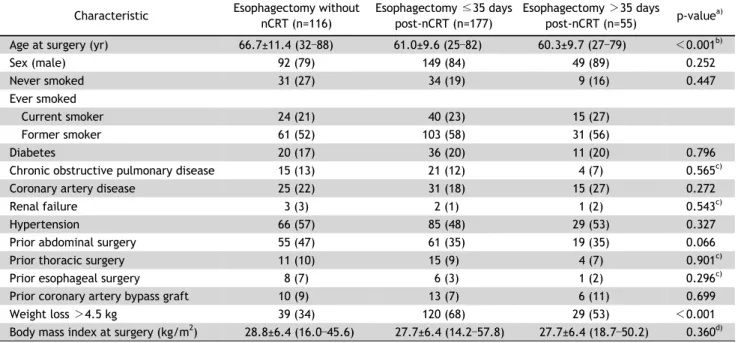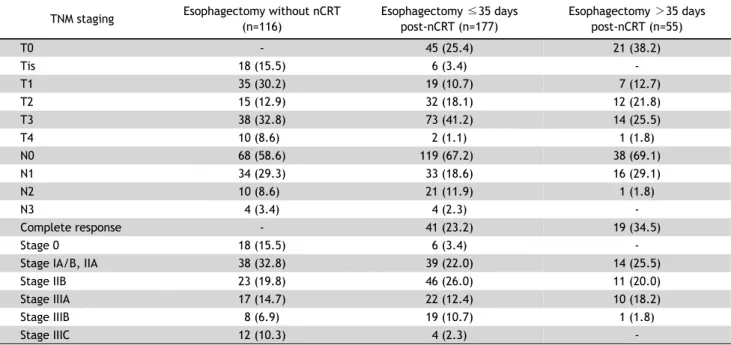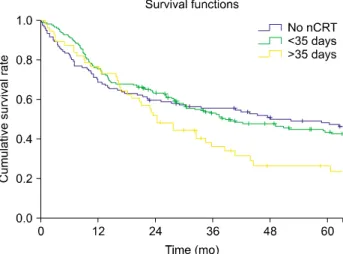ISSN: 2233-601X (Print) ISSN: 2093-6516 (Online)
Received: May 24, 2018, Revised: November 13, 2018, Accepted: November 14, 2018, Published online: February 5, 2019
Corresponding author: Kalpaj R. Parekh, Department of Surgery, University of Iowa Hospitals and Clinics, 200 Hawkins Drive, Iowa City, IA 52242, USA
(Tel) 1-319-353-6758 (Fax) 1-319-356-3891 (E-mail) kalpaj-parekh@uiowa.edu
© The Korean Society for Thoracic and Cardiovascular Surgery. 2019. All right reserved.
This is an open access article distributed under the terms of the Creative Commons Attribution Non-Commercial License (http://creativecommons.org/
licenses/by-nc/4.0) which permits unrestricted non-commercial use, distribution, and reproduction in any medium, provided the original work is properly cited.
Timing of Esophagectomy after Neoadjuvant Chemoradiation Therapy Affects the Incidence of Anastomotic Leaks
Simon Roh, M.D. 1 , Mark D. Iannettoni, M.D. 2 , John Keech, M.D. 3 ,
Evgeny V. Arshava, M.D. 3 , Anthony Swatek, M.D. 3 , Miriam B. Zimmerman, Ph.D. 4 , Ronald J. Weigel, M.D., Ph.D. 3 , Kalpaj R. Parekh, M.B.B.S. 3
1
Division of Interventional Radiology, New York Presbyterian Hospital – Weill Cornell Medical Center,
2Department of Cardiovasular Sciences, East Carolina University,
3Department of Surgery, University of Iowa Hospitals and Clinics,
4
Department of Biostatistics, University of Iowa College of Public Health
Background: Neoadjuvant chemoradiation therapy (nCRT) has become the standard of care for esophageal cancer patients prior to esophagectomy. However, the optimal timing for surgery after completion of nCRT remains unclear. Methods: A retrospective review was performed of patients who underwent esophagectomy with cervical anastomosis for esophageal cancer at a single institution between January 2000 and June 2015.
Patients were categorized into 3 cohorts: those who did not receive nCRT prior to esophagectomy (no nCRT), those who underwent esophagectomy within 35 days after nCRT (≤35d), and those who underwent esophagectomy more than 35 days after nCRT (>35d). Results: A total of 366 esophagectomies were per- formed during the study period, and 348 patients met the inclusion criteria. Anastomotic leaks occurred in 11.8% of all patients included in the study (41 of 348). Within each cohort, anastomotic leaks were detected in 14.7% of patients (17 of 116) in the no nCRT cohort, 7.3% (13 of 177) in the ≤35d cohort, and 20.0%
(11 of 55) in the >35d cohort (p=0.020). Significant differences in the occurrence of anastomotic leaks were observed between the no nCRT and ≤35d cohorts (p=0.044), and between the ≤35d and >35d cohorts (p=0.007). Conclusion: Esophagectomy with cervical anastomosis within 35 days of nCRT resulted in a lower percentage of anastomotic leaks.
Key words: 1. Esophageal neoplasms 2. Esophagectomy 3. Anastomotic leak 4. Chemoradiotherapy 5. Neoadjuvant therapy
Introduction
Neoadjuvant chemoradiation therapy (nCRT) fol- lowed by surgery is a common treatment for locally advanced esophageal cancer. Recent studies have suggested that this treatment may improve survival
and provide better local control [1-11], although sev- eral reports have shown no significant benefit [12-16]. Despite these inconsistencies, routine nCRT prior to esophagectomy is becoming a standard practice.
There are concerns that nCRT may make surgery
https://doi.org/10.5090/kjtcs.2019.52.1.1
more difficult because it can cause fibrosis and in- crease postoperative complications [17]. Moreover, nCRT could potentially influence the rates of anasto- motic leaks, which are a complication of esoph- agectomy associated with serious morbidity and mor- tality [18]. However, a recent multicenter study showed that nCRT had no impact on anastomotic leaks in patients who underwent surgery 6–8 weeks after completing treatment [19]. Further, a study by Kim et al. [20] demonstrated that perioperative mor- bidity and mortality did not differ for esophagec- tomies performed less than or more than 8 weeks following nCRT treatment. Although combined-modal- ity treatment regimens may lead to better outcomes, the data currently available are not conclusive re- garding the optimal timing of surgery following nCRT, and prior studies have not specifically focused on the implications of anastomotic leaks [20-25]. The aim of our study was to determine whether the tim- ing of esophagectomy following nCRT affected the in- cidence of anastomotic leaks.
Methods
This study was reviewed and approved by the Institutional Review Board and informed consent was waived. A prospectively collected database of all pa- tients undergoing esophagectomy for esophageal can- cer from January 2000 to June 2015 at the University of Iowa Hospitals and Clinics was retrospectively reviewed. The histological subtypes of esophageal cancer included adenocarcinoma, squamous cell, neu- roendocrine, poorly differentiated, and gastrointestinal stromal tumor. Patients with a cervical esoph- agogastric anastomosis were included in the study;
patients with an intrathoracic anastomosis were excluded. A detailed chart review was performed and the following data were recorded for each patient:
age/sex; smoking history; previous history of dia- betes, chronic obstructive pulmonary disease (COPD), coronary artery disease (CAD), renal failure, or hy- pertension; prior abdominal/thoracic surgery; prior esophageal surgery; prior coronary artery bypass graft (CABG); weight loss greater than 4.5 kg; and body mass index (BMI). As part of staging, all pa- tients underwent computerized tomography scanning of the chest and abdomen, positron emission tomog- raphy scanning, and endoscopic ultrasonography.
1) Patient categorization
Clinically significant anastomotic leaks were de- fined as any anastomoses that required drainage, and/or neck wound infections requiring jejunal feeds and/or parenteral nutrition. Cervical anastomoses were performed using the modified Collard technique.
Briefly, the anastomosis was performed by stapling the posterior wall with an endo GIA stapler (Medtronic, Minneapolis, MN, USA) and oversewing the anterior wall with 2 absorbable monofilament layers of suture. Patients underwent a thin barium esophagram on postoperative day 5–7. All patients with a leak identified on the esophagram were in- cluded in the leak group. Patients with neck wounds that were erythematous and/or draining had the in- cisions opened at the bedside and were considered to have anastomotic leaks.
Patients with identified anastomotic leaks were divided into 3 cohorts based on the timing of esoph- agectomy: those who did not receive nCRT (no CRT), those who underwent esophagectomy within 35 days of completing nCRT (≤35d), and those who under- went esophagectomy more than 35 days after nCRT (>35d). The cutoff point for being at an increased risk for an anastomotic leak rate following nCRT was determined using logistic regression, which was per- formed by analyzing all of the patients who devel- oped an anastomotic leak and taking each time point in days from surgery to determine whether there was an increased risk for a leak. The time point when there was a trend towards a greater risk for an anastomotic leak was calculated. Patients who un- derwent surgery more than 35 days after nCRT had a higher risk of an anastomotic leak than those who underwent surgery at 35 days or less (odds ratio, 2.95; 95% confidence interval [CI], 1.25–7.00; p=0.014).
2) Statistical analysis
Categorical data were analyzed using the chi-square test or the Fisher exact test, as appropriate. Con- tinuous variables were analyzed using analysis of variance. Intergroup comparisons of quantitative vari- ables were analyzed using the Kruskal-Wallis test.
Data were expressed as number of patients, with the
percentage in parentheses, or median with inter-
quartile range. Statistical significance was defined as
p<0.05. Statistical analyses were performed using
IBM SPSS ver. 24.0 (IBM Corp., Armonk, NY, USA).
Table 1. Baseline characteristics of patients who underwent esophagectomy without nCRT, ≤35 days following nCRT, or >35 days fol- lowing nCRT
Characteristic Esophagectomy without nCRT (n=116)
Esophagectomy ≤35 days post-nCRT (n=177)
Esophagectomy >35 days
post-nCRT (n=55) p-value
a)Age at surgery (yr) 66.7±11.4 (32–88) 61.0±9.6 (25–82) 60.3±9.7 (27–79) <0.001
b)Sex (male) 92 (79) 149 (84) 49 (89) 0.252
Never smoked 31 (27) 34 (19) 9 (16) 0.447
Ever smoked
Current smoker 24 (21) 40 (23) 15 (27)
Former smoker 61 (52) 103 (58) 31 (56)
Diabetes 20 (17) 36 (20) 11 (20) 0.796
Chronic obstructive pulmonary disease 15 (13) 21 (12) 4 (7) 0.565
c)Coronary artery disease 25 (22) 31 (18) 15 (27) 0.272
Renal failure 3 (3) 2 (1) 1 (2) 0.543
c)Hypertension 66 (57) 85 (48) 29 (53) 0.327
Prior abdominal surgery 55 (47) 61 (35) 19 (35) 0.066
Prior thoracic surgery 11 (10) 15 (9) 4 (7) 0.901
c)Prior esophageal surgery 8 (7) 6 (3) 1 (2) 0.296
c)Prior coronary artery bypass graft 10 (9) 13 (7) 6 (11) 0.699
Weight loss >4.5 kg 39 (34) 120 (68) 29 (53) < 0.001
Body mass index at surgery (kg/m
2) 28.8±6.4 (16.0–45.6) 27.7±6.4 (14.2–57.8) 27.7±6.4 (18.7–50.2) 0.360
d)Values are presented as mean±standard deviation (min–max) or number (%).
nCRT, neoadjuvant chemoradiotherapy.
a)
By chi-square test.
b)By Kruskal-Wallis.
c)By Fisher exact test.
d)By analysis of variance.
Actuarial survival rates for the 3 cohorts were calcu- lated using the Kaplan-Meier method.
Results
Within the timeframe of this study, a total of 366 esophagectomies were performed to treat esophageal cancer. The most common type of procedure per- formed was transhiatal esophagectomy (n=330).
Other techniques included the Mckeown 3-hole esophagectomy (n=25) and the Ivor Lewis esoph- agectomy (n=11). Several patients were excluded, for the following reasons: the 11 patients who under- went an Ivor Lewis esophagectomy were excluded due to the presence of an intrathoracic anastomosis, 5 patients were excluded due to delayed cervical anastomosis after spit fistula formation during the in- itial operation, and 2 patients were excluded because radiation therapy was administered with curative in- tent at high doses (6,000 cGy and 7,440 cGy).
Intrathoracic anastomoses were excluded, as the ma- jority of our patients had cervical anastomoses and intrathoracic anastomoses only occurred in a small fraction (<5%) of our cohort. The small number
would only confound the data and would not allow a meaningful comparison.
A total of 348 patients met the inclusion criteria.
Overall, 348 anastomoses were assessed for leaks us- ing radiographic imaging unless clinical evidence of a leak was present. The median dose of radiation was 5,040 cGy (range, 4,140–5,600 cGy). Chemotherapy consisted of a platinum-based regimen; the most common agents used were cisplatin/5-fluorouracil and carboplatin/paclitaxel. The median time to sur- gery after completion of neoadjuvant treatment was 28 days. The 30-day operative mortality rate was 2.3% (8 of 348).
Patients were divided into 3 cohorts based on the timing of surgery following nCRT: no nCRT cohort,
≤ 35d cohort, and >35d cohort. The cutoff of 35
days was determined using logistic regression to de-
termine the time at which the incidence of anasto-
motic leaks increased. Table 1 summarizes the demo-
graphic characteristics for each cohort. The patho-
logic staging of the tumors for each cohort is sum-
marized in Table 2. The mean age of patients who
did not receive nCRT was higher (66.7 years) than
that of patients who received nCRT (60.3 years in
Table 2. Pathologic staging of all patients who underwent esophagectomy in this study TNM staging Esophagectomy without nCRT
(n=116)
Esophagectomy ≤35 days post-nCRT (n=177)
Esophagectomy >35 days post-nCRT (n=55)
T0 - 45 (25.4) 21 (38.2)
Tis 18 (15.5) 6 (3.4) -
T1 35 (30.2) 19 (10.7) 7 (12.7)
T2 15 (12.9) 32 (18.1) 12 (21.8)
T3 38 (32.8) 73 (41.2) 14 (25.5)
T4 10 (8.6) 2 (1.1) 1 (1.8)
N0 68 (58.6) 119 (67.2) 38 (69.1)
N1 34 (29.3) 33 (18.6) 16 (29.1)
N2 10 (8.6) 21 (11.9) 1 (1.8)
N3 4 (3.4) 4 (2.3) -
Complete response - 41 (23.2) 19 (34.5)
Stage 0 18 (15.5) 6 (3.4) -
Stage IA/B, IIA 38 (32.8) 39 (22.0) 14 (25.5)
Stage IIB 23 (19.8) 46 (26.0) 11 (20.0)
Stage IIIA 17 (14.7) 22 (12.4) 10 (18.2)
Stage IIIB 8 (6.9) 19 (10.7) 1 (1.8)
Stage IIIC 12 (10.3) 4 (2.3) -
Values are presented as number (%).
TNM, tumor–node–metastasis; nCRT, neoadjuvant chemoradiotherapy.
Table 3. Timing of esophagectomy after nCRT and its effect on anastomotic leak incidence
Timing of nCRT With anastomotic leak p-value
a)Pairwise comparison Post-hoc adjusted p-value
No nCRT (n=116) 17 (14.7) 0.020 No nCRT vs. ≤35 days 0.044
nCRT ≤35 days prior to surgery (n=177) 13 (7.3) No nCRT vs. >35 days 0.378
nCRT >35 days prior to surgery (n=55) 11 (20.0) ≤35 days vs. >35 days 0.007
Values are presented as number (%), unless otherwise stated.
nCRT, neoadjuvant chemoradiotherapy.
a)


